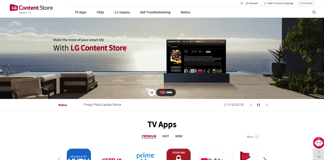Share this
Going Big Screen: How to bring your apps to LG WebOS?
by Pieter-Jan Speelmans on February 2, 2021
THIS IS A SNIPPET FROM OUR “GOING BIG SCREEN: BRINGING VIDEO TO LG WEBOS” GUIDE WHICH YOU CAN DOWNLOAD HERE.
“Streaming is gaining ground over traditional viewing” is something we’ve heard before. “The big screen is the undisputed leader” is another one of those quotes. In 2018, streaming on the big screen was however limited to about one third of the total viewing time according to Conviva.
By 2019, this percentage had increased to 55%, so what do the latest 2020 numbers say? About 75% of all viewing happens on the big screen. When we look at the devices with most growth, there is no way around smart TVs which grew for more than 200% during the last two consecutive years, allowing them to gain ground on other connected tv devices such as Fire TV and Roku, which grew only 55% (slightly below the 57% average across platforms).
In our previous blogpost, Going Big Screen: Bringing Video to Samsung's Tizen, we zoomed in on the largest brand in the Smart TV space, being Samsung with its Tizen platform, which accounts for about 7% of all viewing time. Now, we will continue with the second largest brand: LG and its webOS platform which accounts to 3.3% of all viewing time. In this blog, we will discuss how to bring the applications for your streaming services into LG webOS platform.
Bringing Applications to LG WebOS
Since 2014, LG has been making use of webOS as a platform. While the platform has a history with Palm, HP and an open source version existing, the main driver behind webOS is LG which bought the platform in 2013. The platform itself is Linux based, but in its essence developing applications for the platform usually does not happen in languages such as C, but applications tend to run in a web environment.
LG Content Store
Same as most other smart TV platforms, bringing your app on LG’s webOS platform goes through a store: the LG Content Store. Long story short, the LG Content Store has the same process as most application stores, requiring a (often lengthy) review before your app can be published. As in the webOS name however, apps are developed completely in web technology, being HTML5.

Building a Hosted Application
While the web is known for flexible updates, traditional app store processes can slow you down significantly. On webOS however, the “hosted app” approach is quite common: you basically create an app which instructs the platform to load the latest and greatest from the web, same as any old website. While you still have to go through the validation process once to get listed in the LG Content Store, you can bypass future reviews for updates easily giving you the agility which is needed in an era where competition in the streaming landscape is growing by the day.

Building an Application
Building an app for webOS (or a webOS enabled website) is quite simple thanks to web technology being the main driver. Most APIs which are used are following the W3C specifications nicely, making it highly similar to developing your website for any common browser. Actually, you can likely reuse most of your website logic, given some tweaking on the UX side to ensure smooth integrations with LG’s Magic Remote. While the Magic Remote allows you to summon a mouse-like cursor on your screen to navigate (which acts from an API perspective in the same way as any odd mouse on a laptop), using standard remote control buttons (which from an API perspective function as a keyboard) still works quite well (and in most apps, better).
Media Playback on LG WebOS
In order to bring your content to webOS, you of course need to play it. On webOS this is quite simple, you can bring audio or video streaming to webOS in exactly the same way you do on your website:
- You either rely on the native player for basic playback or,
- You load up a “bring your own” video player library to power your unique viewer experiences.
But, do you really need to make a choice between Native vs ‘Bring-Your-Own’? In our next blogposts we are going to discuss what is the most effective way to stream your audio or video to webOS.
You can also download the complete version of this topic in our “GOING BIG SCREEN: BRINGING VIDEO TO LG WEBOS” ebook here. Or if you have any questions, don’t hesitate to reach out to our team.
Share this
- THEOplayer (46)
- online streaming (40)
- live streaming (35)
- low latency (32)
- video streaming (32)
- HESP (24)
- HLS (21)
- new features (21)
- THEO Technologies (20)
- SDK (19)
- THEOlive (17)
- best video player (17)
- cross-platform (16)
- html5 player (16)
- LL-HLS (15)
- online video (15)
- SmartTV (12)
- delivering content (12)
- MPEG-DASH (11)
- Tizen (11)
- latency (11)
- partnership (11)
- Samsung (10)
- awards (10)
- content monetisation (10)
- innovation (10)
- Big Screen (9)
- CDN (9)
- High Efficiency Streaming Protocol (9)
- fast zapping (9)
- video codec (9)
- SSAI (8)
- Ultra Low Latency (8)
- WebOS (8)
- advertising (8)
- viewers expercience (8)
- "content delivery" (7)
- Adobe flash (7)
- LG (7)
- Online Advertising (7)
- Streaming Media Readers' Choice Awards (7)
- html5 (7)
- low bandwidth (7)
- Apple (6)
- CMAF (6)
- Efficiency (6)
- Events (6)
- drm (6)
- interactive video (6)
- sports streaming (6)
- video content (6)
- viewer experience (6)
- ABR (5)
- Bandwidth Usage (5)
- Deloitte (5)
- HTTP (5)
- ad revenue (5)
- adaptive bitrate (5)
- nomination (5)
- reduce buffering (5)
- release (5)
- roku (5)
- sports betting (5)
- video monetization (5)
- AV1 (4)
- DVR (4)
- Encoding (4)
- THEO Technologies Partner Success Team (4)
- Update (4)
- case study (4)
- client-side ad insertion (4)
- content encryption (4)
- content protection (4)
- fast 50 (4)
- google (4)
- monetization (4)
- nab show (4)
- streaming media west (4)
- support matrix (4)
- AES-128 (3)
- Chrome (3)
- Cost Efficient (3)
- H.265 (3)
- HESP Alliance (3)
- HEVC (3)
- IBC (3)
- IBC trade show (3)
- React Native SDK (3)
- THEOplayer Partner Success Team (3)
- VMAP (3)
- VOD (3)
- Year Award (3)
- content integration (3)
- customer case (3)
- customise feature (3)
- dynamic ad insertion (3)
- scalable (3)
- server-side ad insertion (3)
- video (3)
- video trends (3)
- webRTC (3)
- "network api" (2)
- Amino Technologies (2)
- Android TV (2)
- CSI Awards (2)
- Encryption (2)
- FireTV (2)
- H.264 (2)
- LHLS (2)
- LL-DASH (2)
- MPEG (2)
- Microsoft Silverlight (2)
- NAB (2)
- OMID (2)
- Press Release (2)
- React Native (2)
- Start-Up Times (2)
- UI (2)
- VAST (2)
- VP9 (2)
- VPAID (2)
- VPAID2.0 (2)
- ad block detection (2)
- ad blocking (2)
- adobe (2)
- ads in HTML5 (2)
- analytics (2)
- android (2)
- captions (2)
- chromecast (2)
- chromecast support (2)
- clipping (2)
- closed captions (2)
- deloitte rising star (2)
- fast500 (2)
- frame accurate clipping (2)
- frame accurate seeking (2)
- metadata (2)
- multiple audio (2)
- playback speed (2)
- plugin-free (2)
- pricing (2)
- seamless transition (2)
- server-side ad replacement (2)
- subtitles (2)
- video publishers (2)
- viewer engagement (2)
- wowza (2)
- "smooth playback" (1)
- 360 Video (1)
- AOM (1)
- API (1)
- BVE (1)
- Best of Show (1)
- CEA-608 (1)
- CEA-708 (1)
- CORS (1)
- DIY (1)
- Edge (1)
- FCC (1)
- HLS stream (1)
- Hudl (1)
- LCEVC (1)
- Microsoft Azure Media Services (1)
- Monoscopic (1)
- NAB Show 2016 (1)
- NPM (1)
- NetOn.Live (1)
- OTT (1)
- Periscope (1)
- Real-time (1)
- SGAI (1)
- SIMID (1)
- Scale Up of the Year award (1)
- Seeking (1)
- Stereoscopic (1)
- Swisscom (1)
- TVB Europe (1)
- Tech Startup Day (1)
- Telenet (1)
- Uncategorized (1)
- University of Manitoba (1)
- User Interface (1)
- VR (1)
- VR180 (1)
- Vivaldi support (1)
- Vualto (1)
- adblock detection (1)
- apple tv (1)
- audio (1)
- autoplay (1)
- cloud (1)
- company news (1)
- facebook html5 (1)
- faster ABR (1)
- fmp4 (1)
- hiring (1)
- iGameMedia (1)
- iOS (1)
- iOS SDK (1)
- iPadOS (1)
- id3 (1)
- language localisation (1)
- micro moments (1)
- mobile ad (1)
- nagasoft (1)
- new web browser (1)
- offline playback (1)
- preloading (1)
- program-date-time (1)
- server-guided ad insertion (1)
- stream problems (1)
- streaming media east (1)
- support organization (1)
- thumbnails (1)
- use case (1)
- video clipping (1)
- video recording (1)
- video trends in 2016 (1)
- visibility (1)
- vulnerabilities (1)
- zero-day exploit (1)
- November 2024 (1)
- August 2024 (1)
- July 2024 (1)
- January 2024 (1)
- December 2023 (2)
- September 2023 (1)
- July 2023 (2)
- June 2023 (1)
- April 2023 (4)
- March 2023 (2)
- December 2022 (1)
- September 2022 (4)
- July 2022 (2)
- June 2022 (3)
- April 2022 (3)
- March 2022 (1)
- February 2022 (1)
- January 2022 (1)
- November 2021 (1)
- October 2021 (3)
- September 2021 (3)
- August 2021 (1)
- July 2021 (1)
- June 2021 (1)
- May 2021 (8)
- April 2021 (4)
- March 2021 (6)
- February 2021 (10)
- January 2021 (4)
- December 2020 (1)
- November 2020 (1)
- October 2020 (1)
- September 2020 (3)
- August 2020 (1)
- July 2020 (3)
- June 2020 (3)
- May 2020 (1)
- April 2020 (3)
- March 2020 (4)
- February 2020 (1)
- January 2020 (3)
- December 2019 (4)
- November 2019 (4)
- October 2019 (1)
- September 2019 (4)
- August 2019 (2)
- June 2019 (1)
- December 2018 (1)
- November 2018 (3)
- October 2018 (1)
- August 2018 (4)
- July 2018 (2)
- June 2018 (2)
- April 2018 (1)
- March 2018 (3)
- February 2018 (2)
- January 2018 (2)
- December 2017 (1)
- November 2017 (1)
- October 2017 (1)
- September 2017 (2)
- August 2017 (3)
- May 2017 (3)
- April 2017 (1)
- March 2017 (1)
- February 2017 (1)
- December 2016 (1)
- November 2016 (3)
- October 2016 (2)
- September 2016 (4)
- August 2016 (3)
- July 2016 (1)
- May 2016 (2)
- April 2016 (4)
- March 2016 (2)
- February 2016 (4)
- January 2016 (2)
- December 2015 (1)
- November 2015 (2)
- October 2015 (5)
- August 2015 (3)
- July 2015 (1)
- May 2015 (1)
- March 2015 (2)
- January 2015 (2)
- September 2014 (1)
- August 2014 (1)

